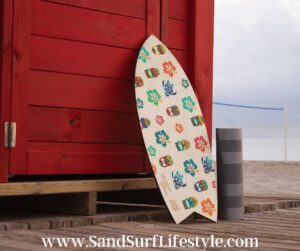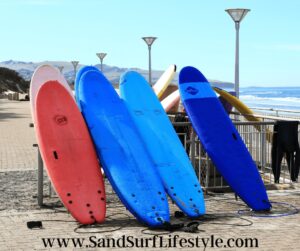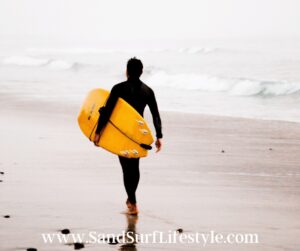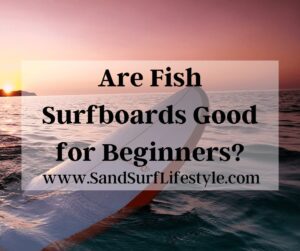Are Fish Surfboards Good for Beginners?
Looking to spend more time on the water? Maybe it is time to explore the incredible world of surfing. Riding the waves offers challenges, excitement, a sense of accomplishment, and fun. Besides don’t we all think surfers are just cool and amazing?
Fish surfboards are an excellent choice for some beginners. Depending upon the waters in which you will learn such as mushy waves, the fish surfboard might be for you. Otherwise, a longboard provides a super option for a novice surfer just embarking on their surfing journey.
Before you catch a wave, continue reading for information on when a fish surfboard might be your best option. Details on longboards are also included to guide you to the surf. Then grab your board and catch a wave.
Details About Fish Surfboards for Beginners:
 Fish surfboards are literally shaped like a fish. They have a wider midsection than other boards. That combined with the pointed nose and tail formation creates the fish look. Fish surfboard’s wider outline and the overall volume provides additional buoyancy for a surfer. This can be a great benefit for beginning surfers.
Fish surfboards are literally shaped like a fish. They have a wider midsection than other boards. That combined with the pointed nose and tail formation creates the fish look. Fish surfboard’s wider outline and the overall volume provides additional buoyancy for a surfer. This can be a great benefit for beginning surfers.
One key element of surfing is paddling. When you start surfing, your upper body strength might not be as developed as someone who has been surfing for a while. One of the first techniques you need to master is paddling. Effective paddlers have strong upper bodies similar to swimmers.
The fish board can be an asset while you develop your strength and skills in paddling. With its thickness, additional foam, and wider midsection, the fish has more volume than some other boards. This gives you more buoyancy. Your ability to stay afloat more readily lets you focus on paddling. When paddling to catch a wave, you need to be able to match the speed of the wave.
Another advantage the fish board offers a new surfer is its ability to perform well on small mushy waves. In surfing terms, mushy waves lack speed and are slow forming, which are a challenge to surf. However, the wider template of the fish and its speed of paddling lets a surfer access waves from one to three feet in height.
As a beginning surfer, you can surf in less-than-ideal wave conditions with a fish. Efficient paddling allows you to accelerate and meet the velocity of the waves. Additional foam on the board enhances your ability to float, which lets you catch the wave. You can access more waves, which lets you gain surfing experience in a shorter period of time.
Most surfers will out surf their first board. If you select a fish for your beginner board, the other advantage is that you can perform some tricks on this board. This means your fish surfboard might be your board of choice after your novice days.
Information About Longboards’ Structure for Beginners:
Learning to surf is challenging. Every wave is a new experience. Winds, tides, and swells all affect the waves. Practice is the key to becoming a surfer. The only way to practice is to ride the waves. Your choice of a surfboard must be one on which you can achieve maximum wave count.
 Longboards are highly recommended by many in the surfing community for beginners. Until you master the basics of surfing, you cannot begin to learn different tricks are your board. Getting a longboard is a great way to practice the key elements of surfing. In surfing lingo, longboards are dubbed the log. They have volume, buoyancy, and stability.
Longboards are highly recommended by many in the surfing community for beginners. Until you master the basics of surfing, you cannot begin to learn different tricks are your board. Getting a longboard is a great way to practice the key elements of surfing. In surfing lingo, longboards are dubbed the log. They have volume, buoyancy, and stability.
Surfboard volume is important for new surfers; this is the total space of your board. The overall volume of your board is a measurement of how much flotation or buoyancy you have. Volume for boards is measured in liters; it is a combination of length, width, thickness. This lets you know how much water you are going to displace.
Longboards for beginners are at least 7’ in length; most will be longer depending upon your height. All other measurements of the board will be in proportion to the length. So, your board will be wider and thicker than other boards. All components work together to provide you stability, which is essential for a beginner.
Width is measured from one rail to another at the widest part of the board. A more balanced deck results from a wider board. The thickness of beginner boards is usually 2.5 to 3”. While this reduces some maneuverability, the offset of better buoyancy is worth it for a beginner.
Another note on the composition of your board is to decide on the material for the top of it. Foamies or soft-topped boards are becoming more common. These are made with expanded polystyrene. Since the top is more cushioned, your buoyancy is increased.
You are starting to paddle out to catch your wave. The extra padding makes your board more comfortable as you pull together your paddling strokes. When you wipe out or need to bale out on a wave, the fall does not feel as discouraging. Knowing you have some extra protection with your softcover can give you the boost of confidence needed.
For a beginner having a board with volume, this will let you hone your surfing skills. With a wider body on your longboard, you can ride the waves to the beach. Your focus can be on the proper mechanics of surfing by learning on the correct size longboard.
Is your child into surfing? Here are the 3 Best Surfboards to Buy for a Beginner Child.
Surfing Benefits of Longboards for Beginners:
 Some of the benefits noted for fish surfboards because of their volume will be similar for longboards. The attributes of the longboard will be linked to the surfing skills you need to develop.
Some of the benefits noted for fish surfboards because of their volume will be similar for longboards. The attributes of the longboard will be linked to the surfing skills you need to develop.
Accessing as many waves as you can is the best practice for a beginning surfer. With your longboard, you can surface on days and locations that have smaller waves. Riding and mastering smaller waves lets you progress more quickly to larger and more challenging waves. The buoyancy of your board makes this possible.
Paddling out to catch those waves is faster and easier on a longboard than on a shortboard. Because of the volume of your board and thereby its buoyancy, paddling with a longboard will take less energy. The energy you save can be channeled right into catching another wave. Paddling can be mastered best with a stable board.
In addition, longboards make popping up more doable. Standing up is easier because you can balance better with the stability of your longboard. Once you are upright, you need a stance that lets you be in control of the board and wave. With a longboard, because of its width, you can have a wider stance and spread your feet.
Related Questions
What is an epoxy board?
Epoxy is one option for the final coat to seal your board, which more beginners are choosing. Since it offers such a hard and resilient finish, epoxy-coated boards do not ding as easily as other coatings. Another plus is with the hard shell-like finish, your board is more buoyant.
What is a poly board?
Poly boards are another option for the final coat on your surfboard. Not as many beginners choose this option. More experienced surfers feel it offers a more flexible board, which provides maneuverability. Finishes with poly as not as durable as epoxy, therefore, boards with this finish ding more readily.

Please note: This blog post is for educational purposes only and does not constitute legal or medical advice. Please consult a legal expert or medical professional to address your specific needs.

